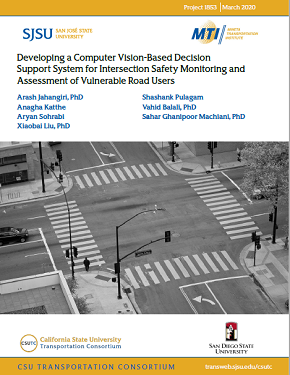- 408-924-7560
- mineta-institute@sjsu.edu
- Donate
Developing a Computer Vision-Based Decision Support System for Intersection Safety Monitoring and Assessment of Vulnerable Road Users
Vision-based trajectory analysis of road users enables identification of near-crash situations and proactive safety monitoring. The two most widely used sur-rogate safety measures (SSMs), time-to-collision (TTC) and post-encroachment time (PET)—and a recent variant form of TTC, relative time-to-collision (RTT —were investigated using real-world video data collected at ten signalized intersections in the city of San Diego, California. The performance of these SSMs was compared for the purpose of evaluating pedestrian and bicyclist safety. Prediction of potential trajectory intersection points was performed to calculate TTC for every interacting object, and the average of TTC for every two objects in critical situations was calculated. PET values were estimated by observing potential intersection points, and frequencies of events were estimated in three critical levels. Although RTTC provided useful information regarding the relative distance between objects in time, it was found that in certain conditions where objects are far from each other, the interaction between the objects was incorrectly flagged as critical based on a small RTTC. Comparison of PET, TTC, and RTTC for different critical classes also showed that several interactions were identified as critical using one SSM but not critical using a different SSM. These findings suggest that safety evaluations should not solely rely on a single SSM, and instead a combination of different SSMs should be considered to ensure the reliability of evaluations. Video data analysis was conducted to develop object detection and tracking models for automatic identification of vehicles, bicycles, and pedestrians. Outcomes of machine vision models were employed along with SSMs to build a decision support system for safety assessment of vulnerable road users at signalized intersections. Promising results from the decision support system showed that automated safety evaluations can be performed to proactively identify critical events. It also showed challenges as well as future directions to enhance the performance of the system.
ARASH JAHANGIRI
Dr. Jahangiri, PhD (Civil Engineering, Virginia Tech, 2015), is an Assistant Professor in the San Diego State University (SDSU) Department of Civil Engineering and the Co-Director of SDSU Smart Transportation Analytics Research (STAR) Lab. His research studies the behavior of current and future transportation systems and aims to improve safety, mobility, and sustainability by utilizing data-driven approaches, emerging technologies, and simulation.
ANAGHA KATTHE
Anagha is currently pursuing her second year as a master’s student in Civil Engineering at San Diego State University with a focus on Transportation Engineering. She received her bachelor’s degree in Civil Engineering from DSCE (Bangalore, India) in July 2014. She worked for three years as an Assistant Transportation Engineer in Bangalore before starting her graduate studies. Her research interests include intelligent transportation systems, connected vehicles, and traffic safety. She likes to keep herself updated by attending transportation conferences and events.
ARYAN SOHRABI
Aryan is a second-year master’s student studying Computational Science with an emphasis in data science at San Diego State University. He received his bachelor’s in Computer Science from McMaster University (Ontario, Canada) in May 2018. His areas of interest are high performance computing, artificial intelligence, and big data.
XIAOBAI LIU
Dr. Liu is an Associate Professor of Computer Science at SDSU and directs the SDSU Computer Vision Laboratory. His research concentrates on developing a unified framework for image and video parsing. He has contributed to new approaches to hierarchical representations of visual data, statistical knowledge discovery, and scalable stochastic inference.
SHASHANK PULAGAM
Shashank obtained his bachelor’s degree in Computer Science and Engineering from University of California, Irvine in June 2018 and is currently a second-year master’s student in Computer Science at San Diego State University. He is interested in Artificial Intelligence and has previous experience in this field from taking classes in Computer Vision, Data Mining, and Machine Learning as well as his involvement in machine vision projects.
VAHID BALALI
Vahid Balali, PhD, is an Assistant Professor in the Department of Civil Engineering and Construction Engineering Management at California State University Long Beach. He is a member of National Center for Transportation, Green Technology, and Education (TransGET). Dr. Balali’s research focuses on the visual data sensing and analytics, virtual design and construction for civil infrastructure and interoperable system integration, and smart cities in transportation for sustainable decision-making.
SAHAR GHANIPOOR MACHIANI
Dr. Machiani, PhD (Civil Engineering, Virginia Tech, 2014), is an Assistant Professor in the San Diego State University (SDSU) Department of Civil Engineering, an Associate Director (SDSU Director) of Safe-D National University Transportation Center, and the Co-Director of SDSU Smart Transportation Analytics Research (STAR) Lab. She has expertise in traffic safety, driver behavior modeling, and infrastructure-based safety systems.
-
Contact Us
San José State University One Washington Square, San Jose, CA 95192 Phone: 408-924-7560 Email: mineta-institute@sjsu.edu






